Introduction
Over the past two decades, the landscape of aesthetic surgery has witnessed a remarkable transformation with a substantial increase in male participation. What was once considered a predominantly female domain is now seeing men embracing various cosmetic procedures not only to enhance their appearance but also to boost self-confidence and career prospects in an increasingly image-conscious society. This narrative explores the growth trends, popular surgeries, and the nuanced reasons behind the expanding male interest in aesthetic procedures.
<!-- VIDEO:eyJsaW5rIjoiaHR0cHM6Ly93d3cueW91dHViZS5jb20vd2F0Y2g/dj1vUDZCR1Z6UWJOUSIsImltYWdlVXJsIjoiZGF0YTppbWFnZS9qcGVnO2Jhc2U2NCwvOWovNEFBUVNrWkpSZ0FCQVFBQUFRQUJBQUQvMndDRUFBa0dCd2dIQmdrSUJ3Z0tDZ2tMRFJZUERRd01EUnNVRlJBV0lCMGlJaUFkSHg4a0tEUXNKQ1l4Sng4ZkxUMHRNVFUzT2pvNkl5cy9SRDg0UXpRNU9qY0JDZ29LRFF3TkdnOFBHamNsSHlVM056YzNOemMzTnpjM056YzNOemMzTnpjM056YzNOemMzTnpjM056YzNOemMzTnpjM056YzNOemMzTnpjM056YzNOLy9BQUJFSUFGTUFsQU1CSWdBQ0VRRURFUUgveEFBYkFBQUJCUUVCQUFBQUFBQUFBQUFBQUFBRUFBSURCUVlCQi8vRUFEWVFBQUlCQXdJRkF3RUhBZ1lEQUFBQUFBRUNBd0FFRVJJaEJSTXhRVkVpWVhHUkJoUXlnYUd4MFVKU0ZWTml3ZUh3SXlRei84UUFHUUVBQWdNQkFBQUFBQUFBQUFBQUFBQUFBZ01BQVFRRi84UUFJeEVBQWdJQ0F3RUFBUVVBQUFBQUFBQUFBQUVDRVJJeEF3UWhRU0lVTWxGaGtmL2FBQXdEQVFBQ0VRTVJBRDhBUFkxR3pWd3RVVE5XV2hvNWpVYk1LYXpWR3pWWlF5WnRxQWtPOUZTblkwRzVva2lpcTQ3RWoyYk9SNmtPeHJOQmZCclRjWmIvQU5DVUQyL2Vzd0hZSDhPYU5Gb3RMQ3dTWjRGY2JPckhVQ1FEN2ZJcTZhZDdYZ0ZuWWFBZ1dRdkpqcTdISkJQNVlGWi9oMXh6TGlHSFFXZG1DSVF4QlhKOXUzV3RSeEN6YTVJamlHaEJnQXNEdGpwK2dvZGJMU2JmaFgzc3Jvdk1DWlZ0OCtLRVRpVG9NYVZyVXg4R0RXNnB6c25IOXZYOWFGZjdOeHhqSkdXOGtISDBCclpEdnhVYVlVdXRPN1FGYjNyM1ZxMFRoVllZd1NPb05OaXRwRmZsck1Ea1p3QnRVUEdPRFhIRHJqTnU2WEVKVlhDcnN5NUFPNC9Qc2FHVzRsWE90WFJoMUFGTTR1UnU4azFZbVNOWjltMVdDV1pabkExQVkxSEdhMEc2TXFvZEpmT1NPdy83aXZQYlNhNWR0S0kyd3psdW1LdWJhN3ZvY0hYa0RPQWQ4L0dmaXB5OVZ5ZVNaRkw0YVpyZU4xdW8wV09PYVJCcWxWZnhEM0hUNTgxQnd4K0lKeEhsM3J4U282N1NKdGdqRzJNZk5CVzNFV1p5OXpoZFFBeU8xR2g5RExLTnlweUt5eWpMamRTQzJhQ1I4TVBpbFVEU0k0VjFZRldVRUdsU00yRlJuaWFZVFhTYVl4cWdUakdvbU5PWTB3MUNFY25TZ0p6ak5IdWFBdU9wb2tSbFR4UnMya3VmRlZWaHdxOXY4dGJ4ZitNSEd0amhmK2EwY05tTDJSb256eWdNdmc5cU1tbnVPZEZhY010bmR1aW9pNEFBOGZ6VnlsOFEzaDQxTDE2QWVDMjMrQlN5UzNhQnB0T2RTaklWZkE5ei9GVzhsMnQ1YnJkMnNpeVJuOFdEMFB4MnBqSmRXOHFROFR0Mmhra0JLYXVqZnpRaVdCaGxuZTFJUjU4Y3dObkczY1V1VlBacmpHdkk2RG91SXZEbFpjRGIwbnpVa0UwMHJhN2VaWk1kWTg5YWM5c3J4S3pJR0NqRzQ2MEhORXNKVjdSRmp3ZlVxakdhVEdsNEhKTWJ4ZTZnbGRDeGVPUWVnbnA4WnF1VzNSbkxhMkM3WXpqZWpialJjbHBDbTJQWFRSWXRPcE52YnBJNFhFZ0hjZG14K2grQjVycjlQdEtseHkvMHdjL0UxK1NJMTVhZi9PZjBqd294VTNOUVI1NXpFbkdNOXM5NmJKdytXM2dMeldFZ2hIVmlwMGplaG11NDB3UkFGeDBZclhSdUwrbVlzRjNjaitsUjlQYXA3UytNSzhxVGREK0UrS3JVdm95bzBzTWZ2VEZrU1Iya0xyb0hUZnBTdWZpeVZOQkptMHMwaUZyR0o1UVRqSzRQUUhjVjJzeGIzOHFvUWpZVUhZR2xYS2wxcDNzWmtpMU5NTk9ZMUd4RklLT05UR3BNMVJrMUNFY2orS0ZaVEk0VWRTYUllaHlRR0lKeG1yc2lWdWl3dDRFaWk1WWJydVQ1cmtvYUZ4a2tnOURRYXZOQTJyVnJUMjdWTEpjcTRIcFkwRW8vVWRDTGl2RHQvUGN6UW1ONUhtakE5QWM1S0hzVlk3L2xTNFZkZmVBT1loRWluREErYWtpanlvSW9xRUxFcE8yU2UxQXAvQzhVbmFKWm4yeDBGVnNyaG1ZSHBSVXBaZ2Q4VlhYTEJSc2R6VmJKWXhtVXFVWEF5ZDZpbnVwN1l4ejJzbkxuak9WSTN6dDBQa2UxZGlZaHNnYmVhcnJtNzF5RWRBTS9uUndYb00ycW8zZkFmdHJhOFY0Tk5iY2JGcEFUcWlrQVlJQ01kUUNmZXFEaHYzWTJSTE9sMUNHWk5TN2h3RGdNUDNyRDNxZ0N0RDlpbTEyVjFFZFI5V3h6dDByUTVOSzBZSEZYUTJmZzA4TVgzbUJ1YkdUbG93TUZQanlLRVNZakJYWWpwN1ZydUdrRkdqYnFEaXFYaVhDSGFVdmFvdXJmV25kdmozclgxdTQzK0V3WlJyUUNremtaSnBWeExXN3hnd01wQndRUmcxeXR0US9rQXY0dU0yTS80WndwOE9NVVRyRERLa0VIdURXQ0NtcFlaWm9qbUtWMFArazRyallqTE51VFRUV2J0K00zVVl4SnBsOGFoajlSVVUvR2I1ejZIUkI0VmY1b2NXU3pTc2FBdW0wa0gzb0N6NDZjaEw1UmovTVFmdVA0cTdpUzF1NHc2bFpFUFJsTkRPV0EzaGhrN0FoY0hBeWFkOTQ3NEdLbHVPSFlVdGJOa2oraHY5alZaTHJqYlM2TXJEc1JRcWFralM0dEZ0RGZlbkc0b2hicFFNNUZaOHRMcE9oVDlhaE56TU1nZzFNRXlrNk5CTGVBblp2eW9JeWN5VHJ0bXF4YmhqMXlLSmlsVURKcXNhTHV3bTZrMHhIVDlLcVRCS1l6STRLanlhS2FYbVBseVFnUGFwTGRKMmg1aUFjdGd3d1JrYkdpWGhNY2pQM1IySXowcXgreWR3MFYvSEdneVpIQ3NQSU5DY1hnYUtaY1JNbk1BOUdEc2NrWUgwcTBzYkc1c0lyZDIyWUhXVkl3VVB6K2ROZjdUSEpWS2pVOHN3WHJEcHEzRkV0RnFrRWk0N0hjK0tpdVpGbmhndWs2ZjFlMmFNdFNIVjR4cExFZW5WMHo3MG1EcGxzcHJ4eEJlem93eWRmMDJGS283NkdWcnVSbVJtWW4xRmR4bWxXMWFGMFpBc29wcGtGUTU5NjVxcFpDVXlWem1WQ1RYTlZRb201bFMydDNKYXljeTNrTWJkKzRiNUZDYXFXYXBwUFphYlhxTmx3M2pjRjNpT2NDT1UrL3BiNE5HenFwWGRRUjRZVmdReEZXTmx4aWUyd3JreVJmMk9jNCtEMi9hczgrQ3ZZbXZqN0h5Wm9UREZwT0FVUGZIU2c1WWRUZGo3aXBQdnNjOXR6SVd5RzIrRDRvVXphTnlkL0ZCRk0wT25vYkluTEJPak5DeVRNUWNDbnlTbHprbkZSVTFJWEwraWZobkVJbmdhS2RjVGRNbm8xWEJ2SUpYdHJjdVZUVUZ3Q05UazdBRHRrKzlaTytqVk5KR3hQV3VjT3RmOFN1MXR6TWtZUDl4Nit3OTZKd1Q5Ri9xSER3OU52N1RodkU1N0M1S3pBUlltbWlXWWxTNHpoWEJHUTJXemtZNk1DdlNvZUtLWjdnSEIvQ0F3T1Q3YlZCWjNxV3lDQ1FOSkdvQzVrWXNUanVhTkJnbjljUlVldzdVbWR1ZVYrQ2sxaTA5Z0ZtQ2hsczN6cGNhby9taUlKQ3VnNXdSMXBUd0ZzU1I3dkdjaWhydDlFY3JyMFpDdytsTWdnR0NDV2VUTWlzMkhKYnI1TktuUktSR2dCN0NsV3FnREVWdzF5bFFsRFRTcFVxb2doU3BVcWhCWnJxczNtdVVxaENhTjJRRmtZcWZiYk5XQTNqVmoxeFNwVXFlelR3czQzU2xTcFZCekt1L2RqUGduYW0yLzR4U3BVeU9qRlBadVlEcjRiYlN0dTdSS1dQazRwQmpHUVVKQjlxVktrQkY1YkV0RUNkemlxN2lJd3N3SFFBMXlsVE9NcGtTOUtWS2xUZ1QvL1oiLCJ0aXRsZSI6Ikdyb3dpbmcgTnVtYmVyIE9mIE1lbiBHb2luZyBVbmRlciBUaGUgS25pZmUgRm9yIFBsYXN0aWMgLi4uIiwic25pcHBldCI6Ikl0J3MgZXNwZWNpYWxseSB0cnVlIGluIG9sZGVyIG1lbiwgYW5kIGl0J3Mgbm90IGp1c3QgZm9yIGxvb2tzLiBDQlMyJ3MgRHIuIE1heCBHb21leiByZXBvcnRzLiJ9 -->Key Facts on Men's Aesthetic Surgery Trends and Influences
- Men’s aesthetic procedureshave increased by approximately 8% in 2023, with 82% being non-surgical.
- The global men's aesthetic market is projected to reach USD 81.2 billion in 2024 and grow at over 13% CAGR.
- Popular procedures include eyelid surgeries, rhinoplasties, facelifts, liposuction, and minimally invasive treatments like Botox and dermal fillers.
- Younger men in their 20s and 30s increasingly pursue early preventative interventions emphasizing natural, subtle results.
- The demand for gynecomastia reduction and liposuction is driven by societal shifts, changing masculinity ideals, and social media influence.
- Global data shows men account for 14.5% of cosmetic treatments, with high demand for Botox, fillers, liposuction, and other minimally invasive options.
- From 2000 to 2018, there's been a 325% increase in male cosmetic procedures, with 'Brotox' up 403%.
- Factors driving popularity include social media, COVID-19 'Zoom Effect', societal acceptance, and advances in safer, faster aesthetic technologies.
- Societal norms, media portrayal, peer influence, and health considerations significantly affect men's decision to pursue aesthetic procedures.
- Future of men's aesthetic market includes personalized treatments and virtual clinics, with an estimated value reaching $5.6 billion by 2026.
1. The Rising Popularity of Minimally Invasive Facial Surgeries Among Men
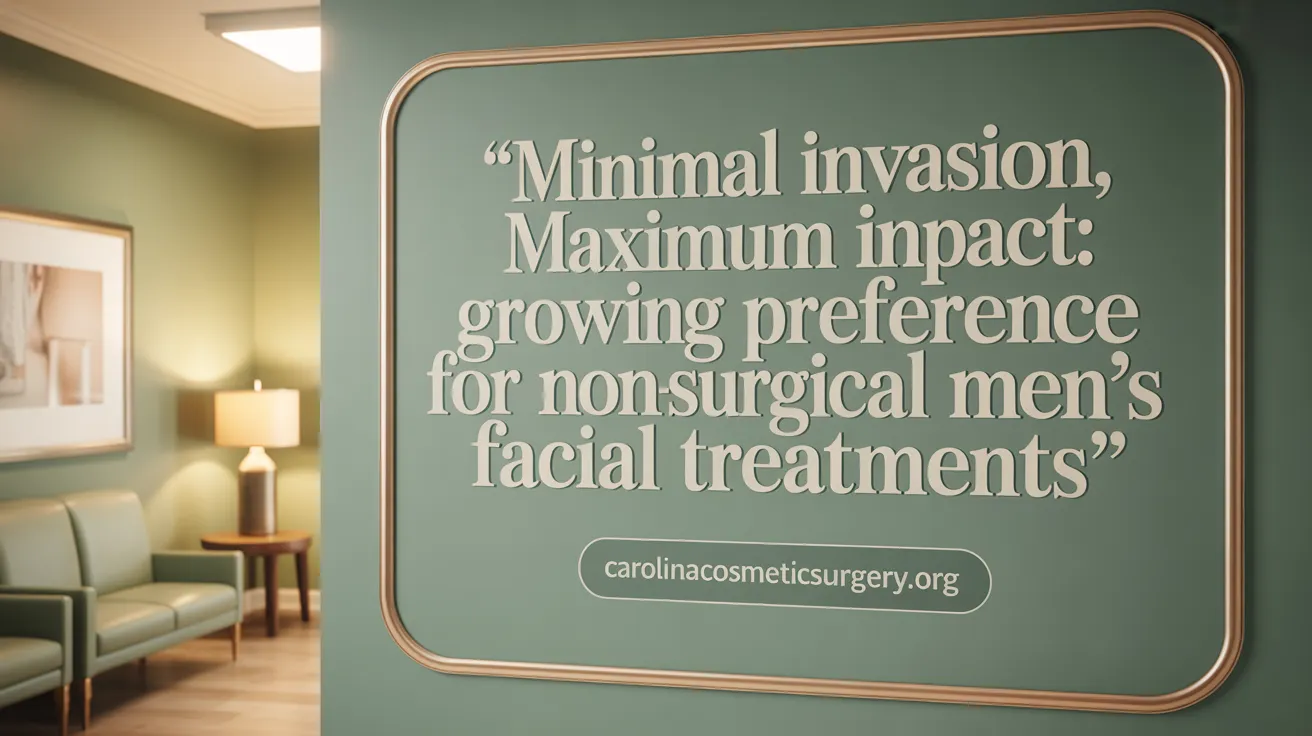
What are the current growth trends and statistics in men's aesthetic surgery?
Men's aesthetic procedures have seen remarkable increase over the last decade. In 2023, male patients accounted for about 6% of all cosmetic procedures in the U.S., with a growth rate of approximately 8% that year. Globally, the market is expanding rapidly, expected to reach USD 81.2 billion by 2024 and projected to continue growing at a compound annual rate of over 13%.
Key procedures such as eyelid surgeries (blepharoplasty), rhinoplasties, facelifts, and liposuction are among the most popular. What's notable is the surge in minimally invasive treatments like Botox, dermal fillers, and laser therapies. In 2023, about 82% of male procedures were non-surgical, reflecting a strong preference for treatments with minimal downtime and natural-looking results.
Younger men, especially those in their 20s and 30s, are increasingly proactive in maintaining their appearance, focusing on early, preventive interventions. The rise in social media influence and changing perceptions of masculinity have helped normalize aesthetic procedures for men.
Advances in technology have enabled safer, faster, and more effective treatments. For example, laser and ultrasound technologies now allow for skin tightening and rejuvenation without surgery. This technological progress, combined with societal acceptance, continues to drive demand among male patients.
In summary, men's aesthetic surgery is experiencing a consistent upward trajectory, driven by technological innovations, shifting cultural norms, and a preference for subtle, natural results. These trends indicate that minimally invasive facial surgeries will remain highly sought after in the coming years.
2. Jawline Enhancement and Body Contouring: Defining Masculinity Through Surgery
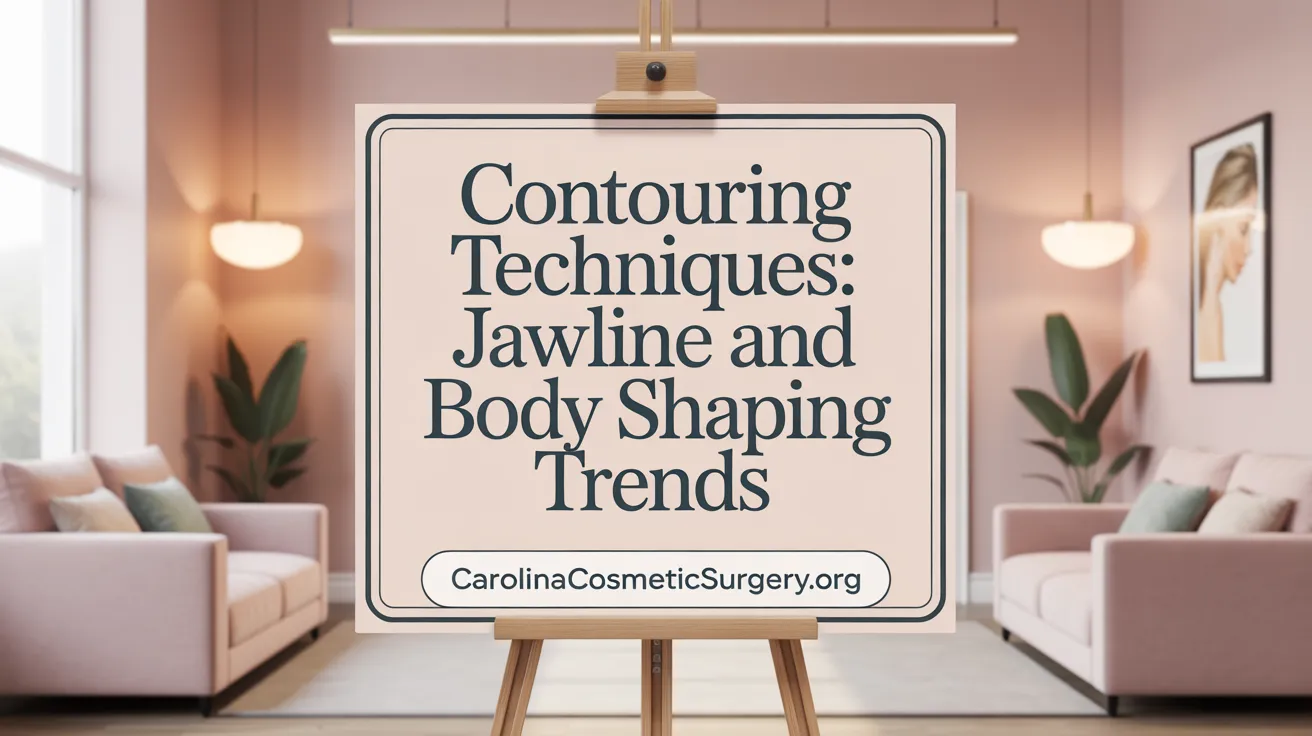
What are popular body and facial contouring procedures among men?
Men are increasingly interested in procedures that emphasize strong, masculine features. Facial contouring often includes jawline enhancement, chin augmentation, and treatments that create a sharp, defined profile. Body contouring procedures such as liposuction of the abdomen, flanks, and chest are also highly sought after to achieve a lean, sculpted physique.
Liposuction remains one of the most popular body procedures, with a focus on removing stubborn fat pockets that are resistant to diet and exercise. Gynecomastia reduction, for instance, targets enlarged breast tissue in men, which can cause discomfort and self-consciousness. This procedure is gaining popularity as societal perceptions of masculinity evolve.
How do surgical and non-surgical jawline enhancement methods compare?
Men seeking to improve their jawline have several options, ranging from surgical implants to non-invasive treatments. Surgical jawline augmentation often involves the placement of implants or bone contouring for a permanent, pronounced effect. Buccal fat removal can also enhance facial definition by reducing cheek fat.
On the non-surgical side, dermal fillers like hyaluronic acid are popular for subtle, immediate results. Kybella injections help eliminate a double chin by dissolving fat, offering a non-invasive alternative with minimal recovery time. These procedures are appealing to men who prefer quick, low-risk treatments with natural-looking outcomes.
Results from non-surgical treatments typically develop within a few weeks and can be maintained with touch-up sessions. Surgical procedures usually provide longer-lasting results but involve longer recovery periods.
What is driving the increased demand for gynecomastia reduction and liposuction?
Changing societal attitudes towards masculinity and body image have led to increased interest in body contouring procedures like gynecomastia reduction and liposuction. Many men want a more muscular, toned appearance, which these procedures can enhance.
Gynecomastia reduction is particularly popular among younger men and those with persistent breast tissue, addressing both aesthetic concerns and potential health issues. Liposuction helps refine body's contours, especially in areas that are difficult to target through exercise.
Economic factors and social media influence also play roles, encouraging men to invest in their appearance to boost confidence and social success.
How do cultural and psychological factors influence the choice of procedures?
Perceptions of masculinity, attractiveness, and success significantly impact men's decision to undergo aesthetic procedures. In many cultures, a strong jawline, defined chin, and muscular body symbolize leadership, strength, and youthful vigor.
Psychologically, procedures like facial rejuvenation and body contouring are linked to improved self-esteem and mental health. Men who seek these procedures often aim to feel more confident both personally and professionally.
The desire for subtle, natural results is paramount, with many men preferring enhancements that do not overly alter their appearance but instead improve harmony and proportions.
What are the typical results duration and patient satisfaction levels?
Results from surgical procedures such as jawline implants or buccal fat removal can last many years, often a lifetime, provided proper care. Non-surgical options, like dermal fillers and neurotoxins, typically last from several months to a year, requiring periodic maintenance.
Patients generally report high satisfaction levels when procedures are performed by experienced, board-certified surgeons, especially when their goals are clearly communicated and realistic expectations are set.
The trend toward minimally invasive treatments and natural results reflects a preference among men for subtle improvements that enhance their features without evident signs of cosmetic work. Overall, satisfaction rates are high when procedures are tailored to individual facial structures and aesthetic desires.
| Procedure Type | Popularity & Trends | Outcome Duration & Satisfaction | Special Considerations |
|---|---|---|---|
| Jawline Enhancement | Most requested facial procedure; non-surgical dermal fillers, surgical implants | Non-surgical: months; Surgical: years; High satisfaction | Natural look preferred; tailored approach essential |
| Gynecomastia Reduction | Growing interest; reduces chest tissue | Long-lasting; high satisfaction with proper technique | Address underlying causes; may require multiple sessions |
| Liposuction (Body) | Continues popularity; focuses on sculpting | Permanent; high satisfaction when well-performed | Combine with skin tightening for best results |
| Blepharoplasty (Eye) | Increasingly popular among men | Results last several years; high satisfaction | Balanced with facial features for natural look |
| Non-invasive treatments (Botox, fillers) | Rising interest; quick and effective | Months; regular maintenance required | Focus on subtle, natural enhancements |
As societal standards evolve, men continue to seek procedures that refine their appearance, boost self-confidence, and reflect their identity, making facial and body contouring an integral part of modern male aesthetic medicine.
Factors Driving the Surge in Male Aesthetic Procedures
What factors are driving the increasing popularity of male aesthetic procedures?
The rise in male aesthetic procedures is a multifaceted phenomenon influenced by social, technological, and cultural factors. One major driver is the changing societal perception of masculinity. Today, there is a growing acceptance and even celebration of grooming and aesthetic enhancements as part of a modern, successful male identity.
Social media plays a crucial role in normalizing and promoting the visibility of male beauty standards. Celebrities, influencers, and everyday users sharing their aesthetic journeys contribute to destigmatizing procedures and making them more accessible and desirable.
The COVID-19 pandemic significantly impacted men's interest in aesthetic treatments. The widespread use of video conferencing technology, popularly called the 'Zoom Effect,' forced many men to scrutinize their facial features more closely from behind a screen. This led to increased demand for facial rejuvenation, minimally invasive procedures like Botox and fillers, and treatments that enhance facial harmony.
Cultural perceptions of masculinity are evolving across regions, particularly in Latin America and Asia. Countries like Brazil, Mexico, South Korea, China, and Japan observe a growing acceptance of aesthetic procedures among men, spurred by changing beauty standards and greater disposable incomes.
Workplace competitiveness and the desire to project a vigorous, youthful image also motivate men to pursue cosmetic procedures. Maintaining a fit, sharp, and confident appearance can influence career success and social status.
Alongside these societal influences, technological advancements have made aesthetic treatments safer, faster, and more effective. Noninvasive options such as neurotoxins, fillers, and laser treatments provide natural results with minimal downtime. These innovations have lowered barriers to entry for men, encouraging them to undergo aesthetic enhancements.
In summary, a combination of shifting societal norms, media influence, the impact of the pandemic, cultural acceptance, and technological progress are all fundamental in driving the growing popularity of male aesthetic procedures.
Global Trends and Future Market Growth in Men's Aesthetic Surgery
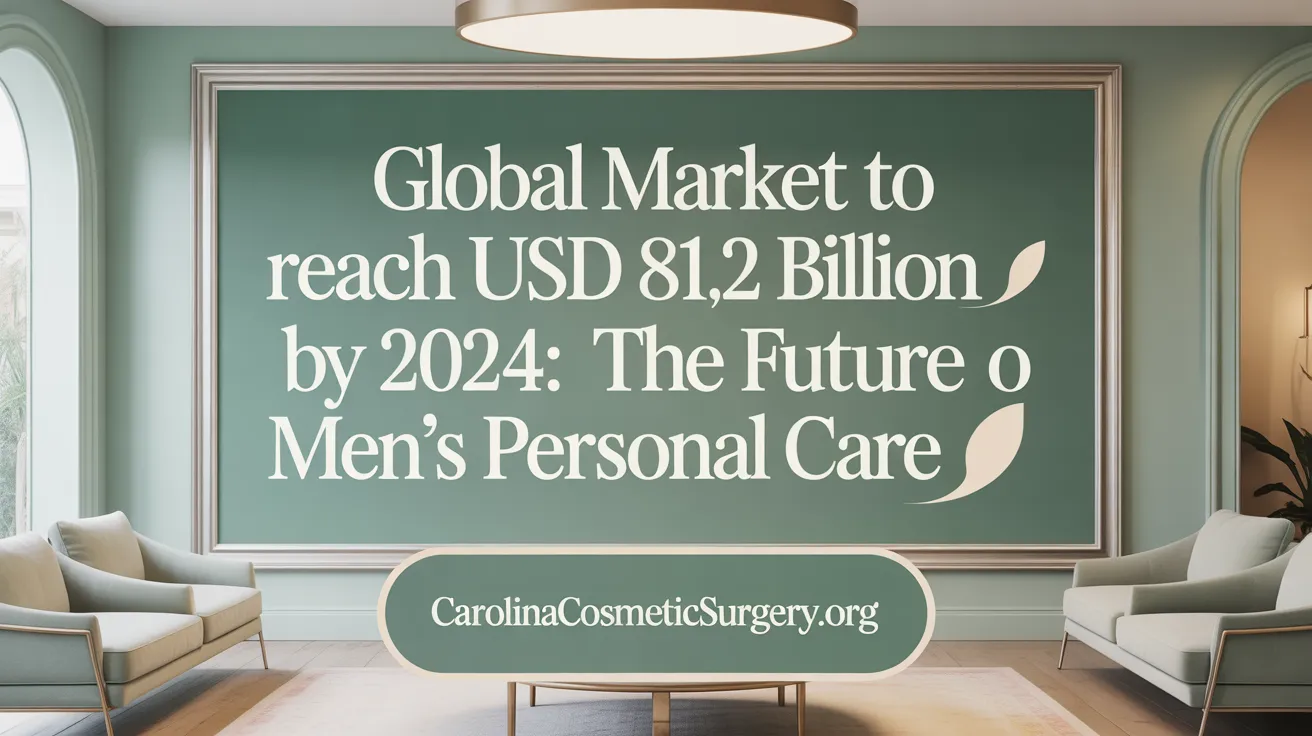
What does data and research reveal about global trends and developments in men's aesthetic treatments?
Research and data from various reputable sources show that the global market for men's aesthetic procedures is experiencing rapid growth and transformation. Over the past decade, there has been a significant increase in men seeking both surgical and nonsurgical treatments to enhance their appearance, driven by societal shifts, greater acceptance of cosmetic procedures, and evolving standards of masculinity.
Men now account for approximately 14.5% of all cosmetic treatments worldwide, with procedures like Botox, fillers, liposuction, gynecomastia reduction, and eyelid lifts showing particularly high demand. The popularity of minimally invasive treatments such as neurotoxins, dermal fillers, laser hair removal, and microneedling continues to grow, favored for their quick results and minimal downtime.
Technological advances are shaping the future of men's aesthetic care. Innovations include personalized, genetically-tailored treatments and virtual "meta-clinics" that offer consultations using augmented reality, making procedures more accessible and tailored to individual needs. These advances contribute to safer, more effective outcomes that emphasize natural, masculine features.
Furthermore, the COVID-19 pandemic amplified interest in facial aesthetics, with more men seeking early intervention and preventative treatments to maintain a youthful look. Societal acceptance is rising, especially in regions like Latin America and Asia, where cultural perceptions of masculinity are evolving, and disposable incomes are increasing.
Looking ahead, industry projections estimate that the market for men's aesthetic procedures will grow at a compound annual growth rate (CAGR) of around 13.38%. By 2026, the global market value is expected to reach approximately $5.6 billion. This growth is reinforced by social media influence, celebrity endorsements, and a broader cultural shift towards body positivity and self-care among men.
In summary, data highlights a vibrant, expanding industry that continues to adapt through technological innovation, cultural shifts, and personalized treatment strategies, promising a dynamic future for men's aesthetic medicine.
Surprising Statistics Behind Male Aesthetic Surgery Growth
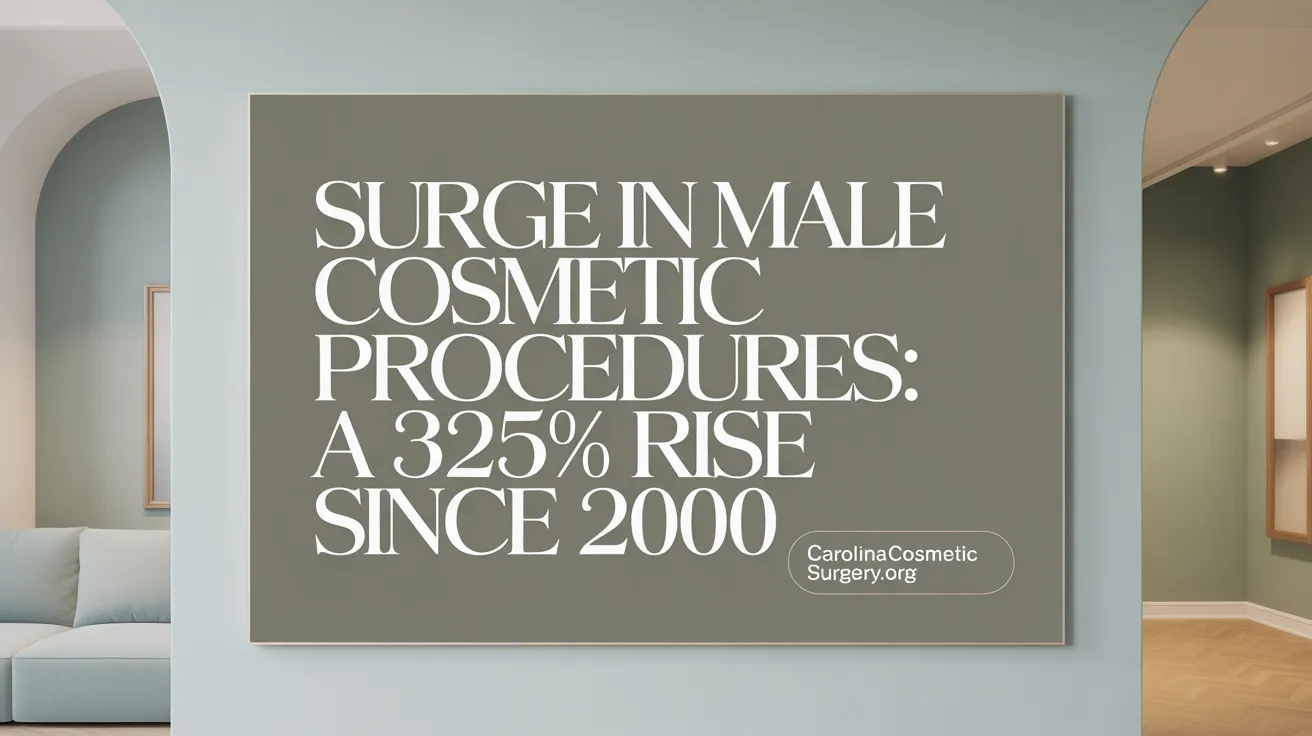
What are some surprising or lesser-known statistics related to male aesthetic surgery?
One of the most striking facts is the dramatic rise in male cosmetic procedures over the last two decades. Since 2000, there has been an increase of approximately 325% in the number of procedures performed on men. This surge signifies changing attitudes and greater acceptance of aesthetic enhancements among males.
Interestingly, younger men—those in their twenties and thirties—are increasingly pursuing procedures traditionally associated with older age groups. Popular options include facelifts, eyelid surgeries, and other facial rejuvenation treatments, often aimed at maintaining a youthful appearance or preventing age-related changes.
The growth in noninvasive treatments is also noteworthy. Procedures like Botox, dermal fillers, microneedling, and CoolSculpting are now among the most searched and requested treatments, often surpassing more invasive options. In fact, Botox for men, known colloquially as 'Brotox,' has experienced a staggering 403% increase in procedures performed from 2000 to 2018.
Certain procedures aimed at enhancing masculinity, such as gynecomastia surgery (breast reduction), hair transplants, and chin augmentation, are highly popular. These procedures focus on creating a more defined jawline, stronger chin, and overall proportionate features.
Overall, the data reveals a clear shift: men now prefer minimally invasive procedures, valuing subtle, natural results that boost confidence and appearance. The societal normalization of male aesthetic procedures, coupled with technological advancements and social media influence, continues to accelerate this trend.
Societal and Health Influences on Men's Decisions for Aesthetic Surgery
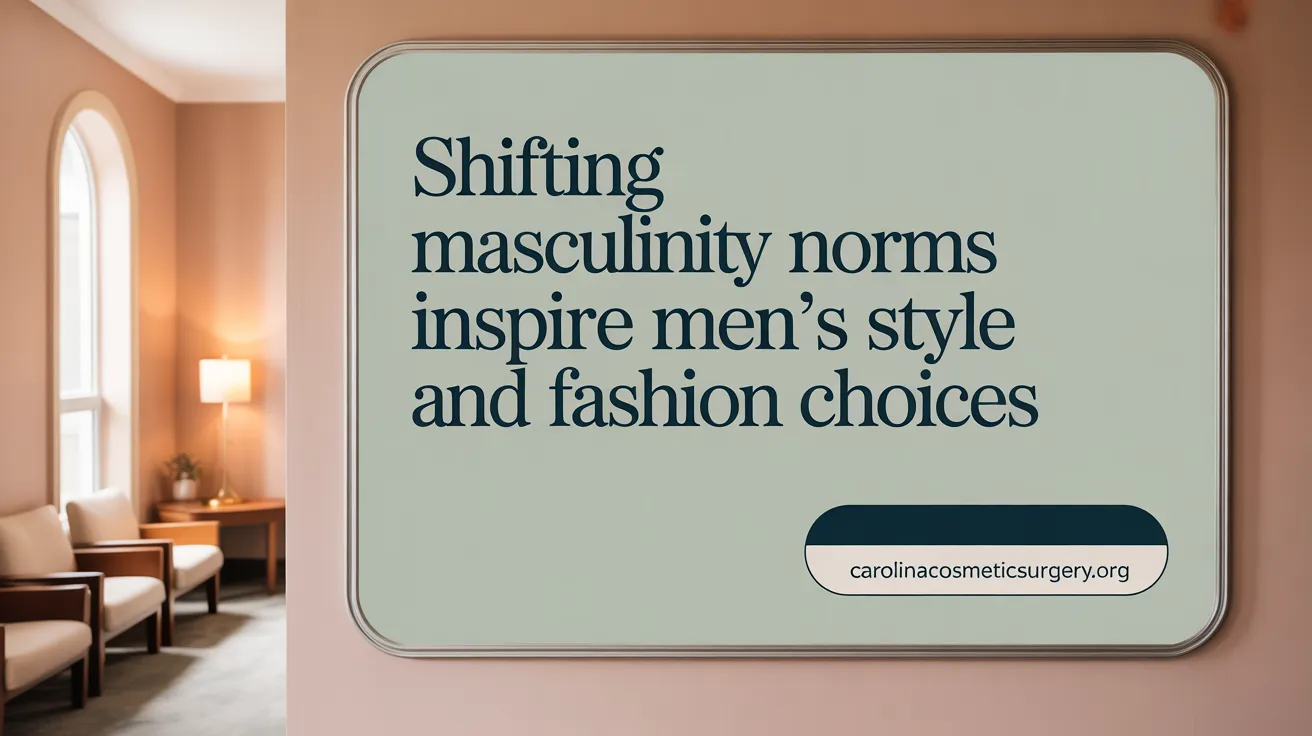
What societal and health factors influence men's decisions to undergo aesthetic procedures?
Men’s choices to pursue cosmetic surgery are shaped by a complex interplay of societal expectations, media influences, and personal health considerations. Evolving standards of masculinity emphasize traits like muscularity, a sharp jawline, and youthful appearance, motivating men to seek procedures that enhance these features.
Societal perceptions of masculinity still influence many men to conform to ideals that highlight strength, virility, and a rugged look. Many men feel societal pressure to meet these standards, which can lead to a desire for procedures such as jawline enhancement, hair restoration, and body contouring.
Media plays a vital role in shaping perceptions by often portraying attractive, youthful, and confident male images. Social media, celebrities, and influencers frequently share their aesthetic journeys, normalizing cosmetic procedures and making them seem more accessible and acceptable.
Peer influence also contributes significantly. Men may feel encouraged by friends or social circles to undergo treatments, especially when success and attractiveness are linked to professional or social achievements.
Health-related factors are another driving force. Age-related changes like sagging skin or hair loss push men to seek rejuvenation options that restore a more youthful appearance. Some men undergo procedures to correct congenital issues or trauma-related defects, improving overall well-being.
Psychologically, self-esteem and body image concerns deeply impact decision-making. Men experiencing dissatisfaction, distress, or self-consciousness about their appearance are more inclined to pursue cosmetic treatments. Conversely, internal self-awareness and confidence can act as buffers against unnecessary procedures.
In summary, societal standards of masculinity, media portrayal, peer influence, health considerations, and psychological well-being all significantly influence men’s decisions to undergo aesthetic surgery. These factors combine to create a cultural environment where embracing aesthetic procedures is increasingly normalized and desired.
Conclusion
The upward trajectory in men’s engagement with aesthetic surgery reflects broader cultural shifts and advancements in medical technology, making cosmetic enhancements more accessible and socially acceptable for men. Popular procedures have evolved from largely surgical options to a spectrum including minimally invasive and non-surgical treatments tailored to masculine aesthetics. This trend is fueled by influences such as social media, workplace demands, and an increasing focus on health and wellness, which together redefine male beauty standards. As the market continues to grow and innovate, men’s aesthetic surgery promises to maintain its momentum, driven by demand for natural, subtle enhancements that emphasize confidence and individuality.
References
- The growing appeal of plastic surgery among men
- The Rise of Male Jawline Enhancement: Why It's the Most ...
- Changing Aesthetic Surgery Interest in Men: An 18-Year ...
- The Growing Male Market in Medical Aesthetics
- Rising Male Plastic Surgery Rates Reflect Growing Body ...
- Analysis of Male Plastic Surgery Content on TikTok
- The Surprising Rise of Male Plastic Surgery
